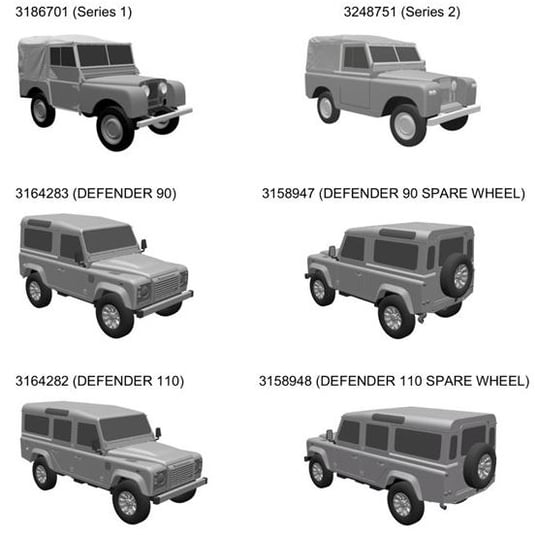
UK High Court (HC) upholds decision of UK IPO to refuse registration of Jaguar Land Rover (JLR)’s 3D shape marks depicting the Land Rover Defender 90 and 110 car models. HC rejects JLR’s plea that UK IPO incorrectly assessed survey evidence by quantifying the degree of recognition of the car models represented by the shape marks at 20-40%.
Background
In 2016-7, JLR applied to register the following three-dimensional shape marks in the UK in relation to a range of goods and services, notably, vehicles and spare parts, badges, toy and model vehicles and maintenance, repair and customisation services.

Following examination, objections were raised against the applications as the marks were considered to be descriptive of a sports utility vehicle and toy models of vehicles and lacked any inherent distinctive character. The scope of the objection was subsequently narrowed at a hearing and JLR later submitted evidence of acquired distinctive character in relation to the remaining objectionable goods. The applications were accepted for registration in 2017.
INEOS Industries Holdings Limited (Ineos) opposed the applications based on various grounds, including allegations the marks are descriptive, non-distinctive and the applications were filed in bad faith. In 2019, the oppositions were upheld by the UK IPO Tribunal (“the contested decision”).
JLR appealed the contested decision to the HC. The grounds of appeal included:
- Inherent distinctive character - the Hearing Officer did not apply the test of whether the marks depart significantly from the norms and customs of the sector correctly; and
- Acquired distinctive character – the Hearing Officer did not apply the relevant test that a significant proportion of relevant average consumers would perceive the shapes applied for, without further indication, as distinguishing goods which have been placed on the market by JLR, or with its consent, from those of other undertakings Notably, JLR took issue with the Hearing Officer’s treatment of the survey evidence.
By a decision of 3 August 2020, the HC upheld the UK IPO’s decision to refuse JLR’s trade mark applications.
Inherent distinctive character - norms and customs of the sector concerned
The test for the inherent distinctiveness of three-dimensional marks is whether they depart significantly from the norms and customs of the sector concerned by the average consumer. In the contested decision, the Hearing Officer noted the principles established in London Taxi[1], concluding that passenger cars is the relevant sector.
In this regard, the Hearing Officer reached the following conclusions, to which JLR objects:
- Differences in design that appear important to design expert may be unimportant, or may not even register, on average consumers of passenger cars. It is therefore doubtful whether many of the design differences considered important to JLR’s design expert would be regarded as significant departures from the norms and customs of the sector by average consumers of passenger cars;
- Evidence in the form of published commentaries by journalists and other third parties in the motor industry “depend, at least in part, on the writers' familiarity with the shapes(s) because of their long use in trade". Hence, the significance of such evidence lies in the context of acquired, as opposed to inherent, distinctive character; and
- Certain features of the Land Rover Defender, namely the arrow shot rear windows and alpine side windows, are no more than minor variations of the norms and customs of the passenger car sector.
Firstly, the HC observed that it is not entitled to substitute its own assessment for that of the Hearing Officer, unless there has been a material error in law or their findings are wrong. In relation to each of JLR’s pleas with regards to the assessment of inherent distinctiveness, the HC was satisfied the Hearing Officer’s views were entirely consistent with jurisprudence and did not disclose any error of principle.
Acquired distinctive character - survey evidence
In the contested decision, the Hearing Officer noted “the key question is whether JLR has shown that a significant proportion of relevant average consumers would perceive the shapes applied for, without further indication, as distinguishing goods which have been placed on the market by JLR, or with its consent, from those of other undertakings".
JLR’s expert submitted a survey, which allegedly showed that 50% of respondents were confident that the pictures shown to them depicted a Land Rover Defender 90. In the contested decision, the Hearing Officer indicated this figure was “somewhere between 20 and 40%”, therefore the survey shows, in his opinion, “a significant, but not overwhelming degree of recognition of the shape of the Land Rover Defender.” JLR alleged the Hearing Officer conducted a flawed analysis because the figures provided were not readily explicable and not consistent with the expert evidence.
The HC agreed with the Hearing Officer that 40% of respondents mentioned Land Rover (or Defender or Discovery) in terms that did not clearly undermine the case for saying the shapes function as trade marks. The difference of 10% between the Hearing Officer’s opinion and JLR’s expert was that 10% of the responses were considered to clearly undermine that case. Further, of the 40%, the Hearing Officer identified a sub-group of respondents who identified, unequivocally, that the photos depicted a Land Rover Defender, which he put at 20%. Therefore, the Hearing Officer reached 20% for the minimum of respondents who unequivocally identified a Land Rover from the photographs and 40% as the maximum. Conducting its own analysis, the HC came up with 25% for the unequivocal responses, but recognised the element of subjectivity in the assessment and the merit in adopting a stricter approach. Hence, the Hearing Officer’s assessment was deemed justifiable and no error of principle was found.
As for the Hearing Officer’s conclusion that “a significant, but not overwhelming degree of recognition of the shape of the Land Rover Defender”, the HC confirmed the Hearing Officer was correct to question whether the survey showed that a substantial proportion of relevant consumers had come to perceive the shape of the Defender as an indication of origin, pursuant to the Nestlé decision[2]. This is because the simple mention of Land Rover and no other brand in response to photos of the Defender’s shape does not equate to the respondents regarding the shape, in isolation, as distinguishing the goods of JLR from those of competitors, as distinct from mere recognition or association. The HC confirmed the Hearing Officer’s approach was entirely consistent with authorities on this subject.
Take away points
This case confirms the position of the courts with regards to the test for distinctiveness of non-traditional trade marks and the approach to the assessment of survey evidence. JLR is not the first, and certainly won’t be the last, of brand owners losing a battle over non-traditional trade marks. The Land Rover Defender is an addition to the list of shape marks, along with the KitKat four-finger chocolate bar and the Rubik’s cube, which also failed to meet the relevant legal criteria.
[1] London Taxi Corporation Limited v Frazer-Nash Research Limited and Anor [2017] EWCA Civ 1729
[2] Société de Produits Nestlé v Cadbury UK Ltd [2017] EWCA Civ 358
This blog was originally written by Pollyanna Savva.
Andy is a Head of Trade Marks and member of our Management Board. He is a Partner and Chartered Trade Mark Attorney who handles a wide range of trade mark work, from searches, portfolio reviews and devising filing strategies to prosecution of applications, oppositions, revocation and invalidity actions. Andy has extensive experience representing clients at the UKIPO, EUIPO and WIPO (for international ‘Madrid Protocol’ registrations).
Email: andy.king@mewburn.com
Sign up to our newsletter: Forward - news, insights and features
Our people
Our IP specialists work at all stage of the IP life cycle and provide strategic advice about patent, trade mark and registered designs, as well as any IP-related disputes and legal and commercial requirements.
Our peopleContact Us
We have an easily-accessible office in central London, as well as a number of regional offices throughout the UK and an office in Munich, Germany. We’d love to hear from you, so please get in touch.
Get in touch

